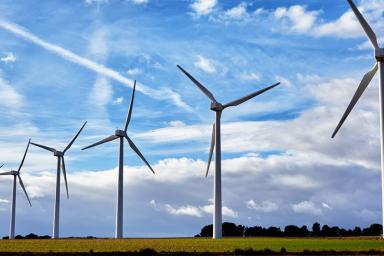Net zero – an A to Z Guide
The push by governments, corporations and organisations to tackle climate change has led to many smaller businesses recognising the UK's commitment to reach net zero emissions by 2050.
With nearly half of all smaller UK businesses rating carbon reduction as a high or very high priority according to a study by the British Business Bank, SMEs may be well-placed to play a pivotal role in shaping the future of rising global temperatures.
Yet, the same study found that many smaller businesses aren't fully aware of what's involved in transitioning to net zero. Over three-quarters (76%) have yet to implement a decarbonisation strategy, with 12% citing a lack of information as a barrier to net zero business operations.
The good news is that nearly all smaller businesses – 94% – have taken at least one action to reduce emissions. But as knowledge is power, our guide to understanding net zero jargon may help demystify some key terms.
Agriculture
Agriculture contributes to the emission of greenhouse gases due to the clearing of land to cultivate crops or for livestock grazing. Livestock manure, fermentation and fertiliser act as sources of methane and nitrous oxide emissions – all of which contribute to the greenhouse effect.
Biodiversity
The variety of life on Earth, including plants, microorganisms and animals. Reaching net zero may help protect the biodiversity of the Earth and maintain the provision of food and water.
Bio-energy
Renewable energy derived from organic materials, which itself is known as biomass. Using bioenergy as a renewable energy source may help meet net zero targets as organic materials can be renewed.
Carbon capture
Trapping carbon dioxide at the emission's source before entering the atmosphere, transporting it to storage and isolating it. Trapping CO2 may help increase the likelihood of reaching net zero emissions.
Carbon emissions
The release of carbon into the atmosphere that studies show to be harmful to the environment. Carbon emissions from human activity need to be balanced by removing greenhouse gases to achieve net zero.
Carbon footprint
The total amount of greenhouse gasses created by activities by individuals, businesses and organisations. Activities to reduce your business carbon footprint include replacing lighting with low-energy LEDs and implementing cycle to work schemes for employees.
Carbon neutral
The balance of everyday carbon emissions made by people, organisations and countries by the removal or elimination of carbon emissions from the atmosphere. For example, business activities such as transport and manufacture may result in carbon emissions, whereas switching energy provision to renewable sources may reduce existing carbon emissions. Being carbon neutral is the point where emissions into the atmosphere are balanced by the amount of carbon being removed from the atmosphere.
Carbon offsetting
An activity that seeks to reduce or remove carbon emissions from the atmosphere. Businesses can carbon offset by, for example planting trees, that are designed to reduce the harmful impact of releasing carbon dioxide into the atmosphere through its removal or through activities that move away from carbon emissions (such as using fossil fuels such as coal or oil) to activities that don’t release carbon dioxide (such as using renewal energy sources such as solar or wind)
Climate change
Long-term shifts in temperature and weather patterns that can be natural or due to human activities.
COP26
Conference of the Parties 26th year: climate change conference. Held in Glasgow in 2021, it discussed aims and targets regarding preventing the rise in global temperature and how countries can act to reach net zero.
Decarbonise
Reducing the number of carbon compounds released. Allowing businesses to decarbonise their emissions may significantly impact the overall amount of carbon in the atmosphere.
Fossil fuels
Fuels formed by natural processes, such as coal. Fossil fuels are formed from plant or animal remains. The burning of fossil fuels releases carbon into the atmosphere, contributing to global warming.
Global warming
The long-term heating and changing of the Earth's climate system, primarily due to human activities. Since the 1800s, human activities have driven an increase in global warming, initially due to the Industrial Revolution through to today's global development.
Greenhouse effect
The warming of the Earth's surface and the lowest atmospheric level caused by greenhouse gases. Greenhouse gases trap the sun's heat in the atmosphere, which contributes to Earth's global warming.
Greenhouse gases (GHG)
Gases that emit and absorb infrared radiation. Gases that contribute to the greenhouse effect. These include CO2, methane and nitrous oxide, which are often released through business activities.
Greenhouse gas emissions
Emissions from human activities that increase the greenhouse effect, adding to climate change.
The Greenhouse Gas (GHG) Protocol
A global methodology that has been developed over the past 20 years to standardise GHG emission calculations.
Green spaces
Open spaces of green such as grass, trees and vegetation etc used for aesthetic, recreational or environmental purposes. Green spaces in urban settings can help reduce the impact of climate change, such as through reducing the urban heat island effect. Businesses can support green spaces either through integrating them into existing business sites, funding the development of community green spaces or through designing in green spaces in new business property developments.
Net zero
Eliminating the amount of greenhouse gas produced by human activity, reducing emissions and absorbing carbon dioxide from the atmosphere to the point where removal and emissions are balanced out, achieving equilibrium or net zero. The UK government has made it law to become a net zero nation by 2050.
Pollution
Contaminants in the natural environment that have harmful effects. These contaminants are usually created by human activity such as transport and landfill waste. They can contaminate the air, water and land.
Renewable resources/energy
Natural resources that do not deplete with use, such as energy produced by tidal, solar or wind sources. Using renewable resources for electricity can help reduce carbon emissions as fossil fuels are not burned.
Sustainable
Management and protection of the Earth and its natural resources for future generations at a maintained level over the long term. Implementing a sustainable lifestyle can involve recycling, using renewable resources and eating a plant-based diet.
Zero carbon
At the most basic level, an activity that emits no GHG emissions during its use phase, such as electricity from wind turbines, could be labelled 'zero-carbon electricity'.
Disclaimer: We make reasonable efforts to keep the content of this article up to date, but we do not guarantee or warrant (implied or otherwise) that it is current, accurate or complete. This article is intended for general information purposes only and does not constitute advice of any kind, including legal, financial, tax, or other professional advice. You should always seek professional or specialist advice or support before doing anything on the basis of the content of this article.
Neither British Business Bank plc nor any of its subsidiaries are liable for any loss or damage (foreseeable or not) that may come from relying on this article, whether as result of our negligence, breach of contract or otherwise. “Loss” includes (but is not limited to) any direct, indirect, or consequential loss, loss of income, revenue, benefits, profits, opportunity, anticipated savings, or data. We do not exclude liability for any liability which cannot be excluded or limited under English law.
Tags related to this content:

Making business finance work for you: Expanded edition
Our Making business finance work for you: Expanded edition is designed to help you make an informed choice about accessing the right type of finance for you and your business.



